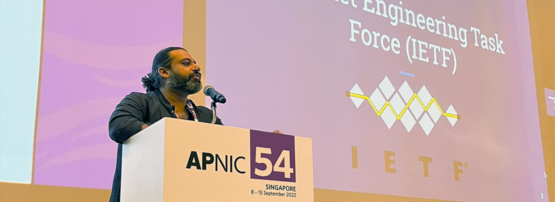
Bob Kahn famously said “The Internet is built on standards. Without standards, there would be chaos.” The Internet Engineering Task Force (IETF) is the premier Internet standards body with an open process and freely available standards for all. The IETF’s mission is to produce high-quality and relevant technical and engineering documents that influence the way people design, use, and manage the Internet in such a way as to make the Internet work better.
During the Connections event that I organized with the India Internet Engineering Society (IIESoc) and Industry Network Technology Council (INTC), APNIC Director General Paul Wilson asked me if we could do more to bridge the gap between the IETF and the APNIC community by regularly sharing information. During APNIC 54 in Singapore, I presented a talk on the IETF and how it functions. I focused on the current level of IETF participation from our region as well as the latest news from the previous IETF meeting.
As Bob Kahn suggested, the quality of the standards and documents produced by the IETF impacts everyone in the industry. It impacts interoperability between vendors, the stability and operations of networks as well as features and services offered to the customer by the service providers. The open process at the IETF allows anyone interested in providing technical contributions to participate.
Standard making usually involves balancing various (and sometimes competing) interests; it is of utmost importance that the unique voice of the operators in the Asia Pacific region is in the room when such decisions are being made. The scale, challenges, and needs of our network are unique, they are often missing and thus ignored. We need to move from silent consumers of standards to full and sustained participation in the standards-making process.
Continuing this tradition, during APRICOT 2023, Paresh Khatri and I will present the latest news from the recent IETF 115 meeting in November as well as prepare for the upcoming IETF 116 in Yokohama from 25 March 2023.
There are several activities at the IETF that are of interest to the operator community! Some key ones are:
- Network operations
- IPv6
- Routing
- DNS
- Research
- Measurement
One event that is tailor-made for the operator community is the Internet Engineering and Planning Group (IEPG). The IEPG is an informal gathering that meets on the Sunday before the IETF meetings. The intended theme of these meetings is essentially one of operational relevance in some form or fashion!
At the November 2022 meeting of the IEPG, there was a discussion on whether IPv6 extension headers can be used on the Internet (and why are they dropped). There were also interesting measurement results of DoH/DoT, which are hot topics for the APNIC community and often discussed on this blog. In the past, there have been several operational topics of BGP, RPKI, DNS, and network attacks to name a few. The IEPG has an open mailing list if you’d like to join these discussions.
As far as the news from the IETF, there is work on updating the MPLS header to support MPLS Network Actions (MNA). This refers to the technologies used to indicate network actions for MPLS packets and to transfer data needed for these actions in the MPLS header. These use cases, requirements and frameworks have been adopted in the MPLS Working Group (WG).
Likewise, the IETF network slicing framework for the key use case of 5G (and beyond) is under final review at the Traffic Engineering Architecture and Signalling (TEAS) WG.
There is a lot of new work being started at the IETF, such as the Time Variant Routing (TVR) WG to address time-based, scheduled changes where predicted variations (restoration, activation, or loss) to the topology are an expected part of normal network operations.
The Source Address Validation in Intra-domain and Inter-domain Networks (SAVNET) WG is examining new techniques for accurate source address validation. The Computing Aware Networking (CAN) BoF examines how compute metrics can be considered by the network edge node as it steers traffic. The RADIUS Extensions Reanimated (RADEXTRA) BoF is advocating reopening the RADIUS protocol to update cryptography. There are also a lot of interesting side meetings.
The IETF strives to distribute the meetings equally between North America, Europe, and Asia. The next IETF meeting, IETF 116, is in Yokohama, Japan from 25 March 2023. Consider participating in person or you can attend remotely. A fee waiver for remote participation is available. The preliminary agenda for the meeting is expected this week and the final agenda by next.
The IETF’s key discussion space is the mailing list and joining relevant mailing lists is the very first step in participation. I wrote about how I started with the IETF in the post a few years back.
Attend the APRICOT 2023 Internet Technology session on Wednesday, 1 March at the Luzon Ballroom where Paresh will go into more detail. I will be remote but feel free to reach out to me for any of your IETF queries at dhruv.ietf at gmail.com.
Dhruv Dhody has been in the networking domain for the last 20 years with Huawei Technologies. They have been an active IETF contributor since 2010 in Path Computation and Traffic Engineering with 37 RFCs as the main author or contributor. They have been recently selected to serve on the Internet Architecture Board (IAB). The views presented here are Dhruv’s only and do not necessarily reflect the views of IETF, Huawei, or any other organization.
The views expressed by the authors of this blog are their own and do not necessarily reflect the views of APNIC. Please note a Code of Conduct applies to this blog.
